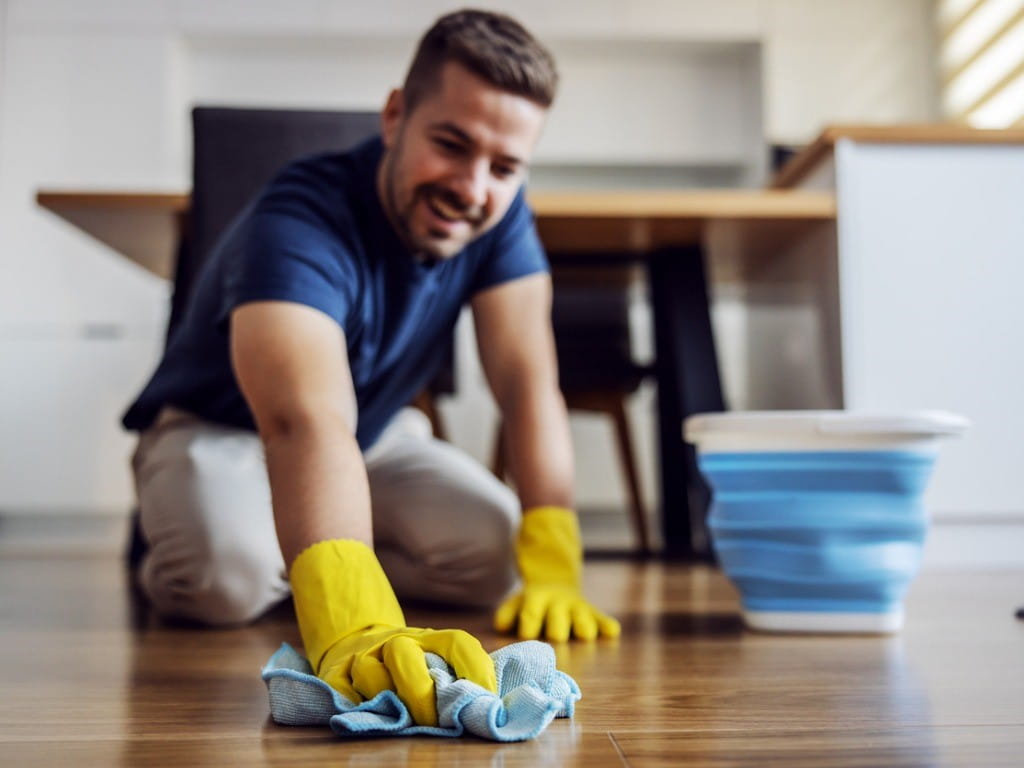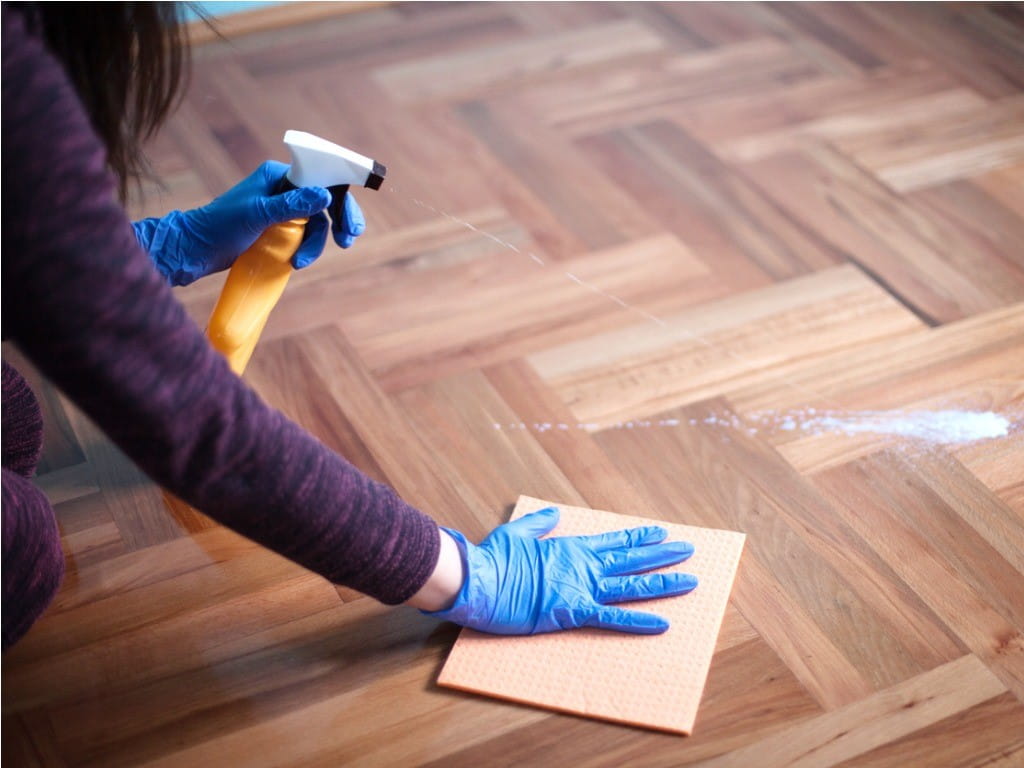What’s in Wood Floor Cleaners?

The Bottom Line
A variety of cleaning products are available to maintain wood floors. Wood floor cleaners are usually based on hydrocarbons, detergents, or glycol ether solvents. Each type carries its own precautions and potential adverse effects. Floor cleaners can also contain alcohol, weak acids, or alkaline chemicals to strengthen their cleaning properties.

The Full Story
Look around your home. Do you have wood floors? If so, you’re in good company. More than half of American homes have wood floors. The North American wood flooring market has been valued at a hefty $4.6 billion annually. Hardwood floors are durable, lend a warm, natural look to living spaces, and they can also increase a home’s value. Homes built in the first half of the 20th century often have solid hardwood floors, while engineered wood flooring types (wood composite with veneer, laminate, and others) have become popular since the 1960s.
Maintaining the beauty of any type of wood floor requires regular cleaning and protection from damage. Microfiber mops or brooms can be used for quick daily cleaning. For more thorough cleaning, use of liquid wood floor cleaners is recommended. Liquid floor cleaners range from those made specifically for wood floors to all-surface cleaners that can be used on wood. Since some vinyl and tile floor cleaners may cause damage to wood floors, always read the product’s label to ensure that it is safe to use on wood surfaces. Websites such as HGTV and Better Homes & Gardens also describe “natural” homemade wood floor cleaning solutions such as diluted vinegar, Castile soap, or tea.
Like many other cleaning products, the labels of wood floor cleaners often list chemical ingredients with hard-to-pronounce names. If you contact Poison Control for information on specific products, they can check their databases for ingredients and potential toxic hazards. You can also look for products that are UL GREENGUARD certified, meaning they emit minimal fumes, which make them safer to use indoors.
There are three basic types of wood floor cleaner formulations:
Hydrocarbon-based floor cleaners often contain Stoddard solvent (mineral spirits), which is a petroleum-based mixture used in dry cleaning, mechanical shops, and painting. Because of their chemical structure and physical characteristics, hydrocarbons such as Stoddard solvent can cause lung injury if they are swallowed. Exposure to Stoddard solvent can also cause irritation of the eyes, skin, mouth, and throat.
Anionic/nonionic detergent-based floor cleaners have very low toxicity in humans. These cleaners contain surfactants that have wetting and foaming properties. If swallowed, they might cause gastrointestinal irritation, including nausea, vomiting, and diarrhea.
Glycol ether solvent-based floor cleaners are the most common type. There are several different solvents in this category that usually contain “glycol” and “ether” in their names—common examples are ethylene glycol monobutyl ether and ethylene glycol monomethyl ether. Chemicals in this class are very effective for dissolving grime and stains. They are usually found in concentrations of 1–5%, but some products contain up to 10% glycol ethers. Large ingestions of glycol ethers may result in significant human toxicity, including altered mental status and metabolic disturbances. Smaller, unintentional ingestions of less than 10 milliliters of commercially available glycol ether-based cleaning solutions are generally benign and not associated with significant adverse events.
Some wood floor cleaners contain extra ingredients to boost cleaning strength:
- Isopropyl alcohol is found in some floor cleaners at concentrations up to 5% (rubbing alcohol usually contains 70% isopropyl alcohol). When ingested, isopropyl alcohol can cause nausea, vomiting, abdominal pain, and gastrointestinal bleeding.
- Citric acid has a low potential for toxicity. It might cause irritation of the skin, eyes, and stomach.
- A few products contain alkaline agents, which give them a very high pH (around 13). Alkaline cleaners are corrosive and can cause severe burns after even small swallows or brief exposure to skin and eyes.
Clearly, there is much variability in possible ingredients among the many available wood floor cleaners; choosing the best product is complicated. Poison Control can look up active ingredient information before you buy and advise you what to do should an exposure occur. Of course, a little prevention is best, so read the label, dilute the product as directed, ventilate the area well, and protect your eyes and skin while using the cleaner. Also, keep kids and pets away until the floor has dried.
If you think that someone has been unintentionally exposed to floor cleaner, check the webPOISONCONTROL® online tool or call Poison Control at 1-800-222-1222 for help 24 hours a day, every day.Leslie A. McCament-Mann, PhD, RPh
Clinical Toxicologist
Poisoned?
Call 1-800-222-1222 or
Prevention Tips
- Read and follow the directions for use on labels of household cleaners.
- Research the toxicity of household cleaners before you choose one. They often contain mixtures of different chemicals, and product information might not be available from some manufacturers.
- Store household cleaners in a secure cabinet or locked area, away from children and pets.
- Never transfer a household cleaner into a different container, especially a food or drink container.
- Avoid mixing household cleaners. Some cleaners can generate toxic fumes when mixed.
This Really Happened
Case 1. A 10-month-old girl was seen in an ER about 45 minutes after her parents heard her take a gulp of a hardwood floor cleaner. The family promptly gave her some water to drink. The ER physician reported to Poison Control that the girl had no symptoms and that she was playful and alert. The product’s ingredients were a proprietary mixture (trade secret), so the product contents were not available to Poison Control. General recommendations were given to watch the girl for persistent vomiting or cough. She did well and was sent home after observation in the ER.
Case 2. A 49-year-old woman came to a clinic stating that she unintentionally drank 1½ cups of a hardwood floor cleaner approximately 12 hours earlier. She drank some water at the time, and she vomited afterward. In the clinic, the woman complained of dizziness. Poison Control was contacted first by the clinic and then by the ER. The active ingredient in the floor cleaner was dipropylene glycol methyl ether (a glycol ether compound). Because of the large amount swallowed, the patient was transported to the hospital for further observation. Toxicity concerns included possible kidney damage, low potassium and calcium, acidosis, and blood and crystals in the urine. The woman was given IV fluids and monitored for symptoms. She was released home when no further problems developed. All lab tests remained normal.
For More Information
How to clean hardwood floors. HGTV; 2021 Jan 01 [cited 2021 May 27].
References
Poisoned?
Call 1-800-222-1222 or
Prevention Tips
- Read and follow the directions for use on labels of household cleaners.
- Research the toxicity of household cleaners before you choose one. They often contain mixtures of different chemicals, and product information might not be available from some manufacturers.
- Store household cleaners in a secure cabinet or locked area, away from children and pets.
- Never transfer a household cleaner into a different container, especially a food or drink container.
- Avoid mixing household cleaners. Some cleaners can generate toxic fumes when mixed.
This Really Happened
Case 1. A 10-month-old girl was seen in an ER about 45 minutes after her parents heard her take a gulp of a hardwood floor cleaner. The family promptly gave her some water to drink. The ER physician reported to Poison Control that the girl had no symptoms and that she was playful and alert. The product’s ingredients were a proprietary mixture (trade secret), so the product contents were not available to Poison Control. General recommendations were given to watch the girl for persistent vomiting or cough. She did well and was sent home after observation in the ER.
Case 2. A 49-year-old woman came to a clinic stating that she unintentionally drank 1½ cups of a hardwood floor cleaner approximately 12 hours earlier. She drank some water at the time, and she vomited afterward. In the clinic, the woman complained of dizziness. Poison Control was contacted first by the clinic and then by the ER. The active ingredient in the floor cleaner was dipropylene glycol methyl ether (a glycol ether compound). Because of the large amount swallowed, the patient was transported to the hospital for further observation. Toxicity concerns included possible kidney damage, low potassium and calcium, acidosis, and blood and crystals in the urine. The woman was given IV fluids and monitored for symptoms. She was released home when no further problems developed. All lab tests remained normal.
